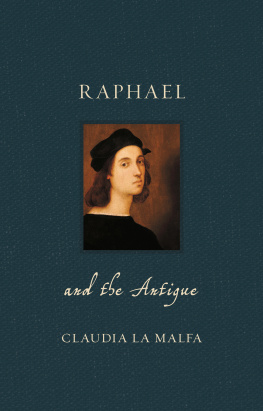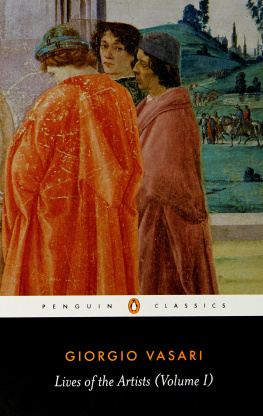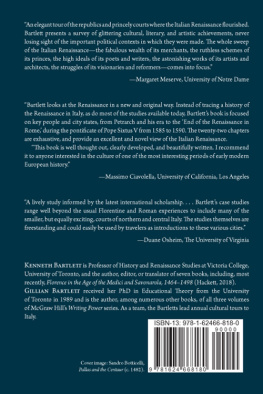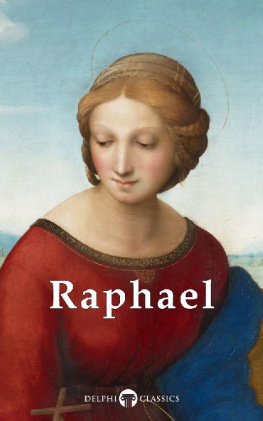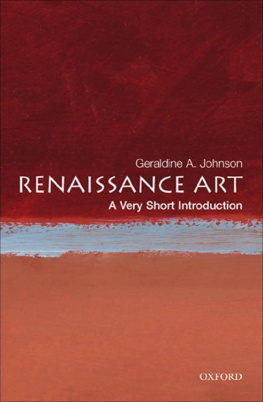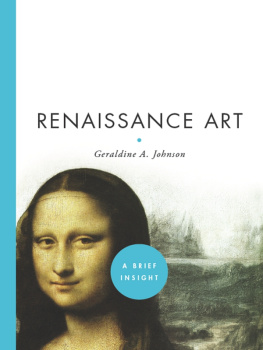
THE
COLLECTOR
OF LIVES

Giorgio Vasari and the
Invention of Art
INGRID ROWLAND
and
NOAH CHARNEY

W. W. NORTON & COMPANY
Independent Publishers Since 1923
New York | London
PRIMARY WORKS
Boccaccio, Giovanni. Decameron.
. Genealogia Deorum Gentilium.
Bottari, Giovanni Gaetano, Raccolta di Lettere sulla Pittura, Scultura e Architettura Scritte da pi celebri personaggi dei secoli XV, XVI, eXVII pubblicata da M. Gio. Bottari e continuata fino ai nostri giorni da Stefano Ticozzi (Rome: Pagliarini, 1757; Milan: Silvestri, 1822).
Cellini, Benvenuto. Vita di Benvenuto Cellini orefice e scultore fiorentino scritta da lui medesimo. Edited by Francesco Tassi. Florence: Guglielmo Piatti, 1829.
. Autobiography. Translated by John Addington Symonds. New York: Appleton, 1904.
Dante Alighieri. Divina Commedia.
Gaye, Johann Wilhelm. Carteggio inedito dartisti dei secoli XIV, XV, XVI. Florence: Presso G. Molini, 1840.
Lapini, Agostino. Diario Fiorentino di Agostino Lapini dal 252 al 1596. Edited by Giuseppe Odoardo Corazzini. Florence: Sansoni, 1900.
Petrarch. Epistolae Familiares.
Scoti-Bertinelli, Ugo. Giorgio Vasari scrittore. Nistri, 1905.
Varchi, Benedetto. Storia fiorentina di Messer Benedetto Varchi. Cologne: Pietro Martello, 1721.
Vasari, Giorgio. Giorgio Vasari: Der literarische Nachlass. Edited by Karl Frey and Herman-Walther Frey. 3 vols. Munich: Georg Mller, 192340. Edited and put online by the Fondazione Memofonte, Florence, at http://www.memofonte.it/autori/carteggio-vasariano-1532-1574.html. [Cited as CV.]
. Le Opere di Giorgio Vasari pittore e architetto aretino. Edited by Stefano Audin (tienne Audin de Rians). 9 vols. Florence: David Passigli e Soci, 1838.
. Vite dei pi eccellenti pittori, scultori, ed architettori. Edited by Rosanna Bettarini and Paola Barocchi. Florence: Sansoni [later S.P.E.S.], 196687. Put online by the Scuola Normale Superiore di Pisa, at http://vasari.sns.it/consultazione/Vasari/indice.html.
. Le Opere di Giorgio Vasari, ed. Gaetano Milanesi, 9 Vols., Florence: Sansoni, 1881.
SECONDARY SOURCES
Alberti, Leon Battista. On Painting: A New Translation and Critical Edition. Edited and translated by Rocco Sinisgalli. Cambridge and New York: Cambridge University Press, 2011.
Alfani, Guido. Calamities and the Economy in Renaissance Italy: The Grand Tour of the Horsemen of the Apocalypse. London: Palgrave Macmillan, 2013.
Barbieri, Costanza. Le magnificenze di Agostino Chigi: Collezioni e passioni antiquarie nella Villa Farnesina. Rome: Accademia dei Lincei, 2014.
Barkan, Leonard. Unearthing the Past: Archaeology and Aesthetics in the Making of Renaissance Culture. New Haven: Yale University Press, 1999.
Barolsky, Paul. Why Mona Lisa Smiles and Other Tales by Vasari. University Park: Pennsylvania State University Press, 1991.
. Giottos Father and the Family of Vasaris Lives. University Park: Pennsylvania State University Press, 1992.
. The Artists Hand. In The Craft of Art: Originality and Industry in the Italian Renaissance and Baroque Workshop. Edited by Andrew Ladis and Carolyn Wood, 524. Athens: University of Georgia Press, 1995.
. Vasari and the Historical Imagination. Word and Image 15 (1999): 28691.
. What Are We Reading When We Read Vasari?, Source: Notes in the History of Art 22, no. 1 (2002): 3335.
. Michelangelos Nose: A Myth and Its Maker. University Park: Pennsylvania State University Press, 2007.
. A Brief History of the Artist from God to Picasso. University Park: Pennsylvania State University Press, 2010.
Barzman, Karen-Edis. The Florentine Academy and the Early Modern State: The Discipline of Disegno. Cambridge and New York: Cambridge University Press, 2000.
Biringucci, Vannoccio. The Pirotechnia of Vannoccio Biringuccio. Translated by Cyril Stanley-Smith and Martha Teach Gnudi. New York: American Institute of Mining and Metallurgical Engineers, 1942.
Blum, Gerd. Giorgio Vasari: Der Erfinder der Renaissance: Eine Biographie , Munich: C. H. Beck, 2011.
Brisson, Luc. How Philosophers Saved Myths: Allegorical Interpretation and Classical Mythology. Translated by Catherine Tihanyi. Chicago: University of Chicago Press, 2004.
Brock, Maurice. Bronzino. Paris: Taschen, 2002.
Brooks, Julian. Taddeo and Federico Zuccaro: Artist-Brothers in Renaissance Rome. Los Angeles: Getty Publications, 2007.
Carden, Robert W. The Life of Giorgio Vasari: A Study of the Later Renaissance in Italy. New York: Henry Holt, 1911.
Cast, David. The Delight of Art: Giorgio Vasari and the Traditions of Humanist Discourse. University Park: Pennsylvania State University Press, 2009.
, ed. The Ashgate Research Companion to Giorgio Vasari. Burlington, CT: Ashgate, 2014.
Celetti, Alessio, Autorappresentazione e la Riforma: Gli affreschi della Sala Regia vaticana, Eurostudium, Jan.March 2013, accessed 4 Oct. 2015, http://www.eurostudium.uniroma1.it/rivista/monografie/Celletti%20pronto.pdf.
Charney, Noah. Stealing the Mystic Lamb: The True Story of the Worlds Most Coveted Masterpiece. New York: PublicAffairs, 2010.
Cheney, Liana de Girolami. Vasaris Teachers: Sacred and Profane Art. London: Peter Lang, 2006.
. The Homes of Giorgio Vasari. London: Peter Lang, 2006.
. Giorgio Vasari: Artistic and Emblematic Manifestations. Washington, DC: New Academia, 2011.
. Giorgio Vasaris Portrait of Lorenzo the Magnificent: A Ciceronian Symbol of Virtue and a Machiavellian Princely Conceit. Iconocrazia, Jan. 2012, accessed 4 Oct. 2014, http://www.iconocrazia.it/archivio/00/02.html.
. Giorgio Vasaris Prefaces: Art and Theory. London: Peter Lang, 2012.
Chieppi, Sergio. I servizi postali dei Medici dal 1500 al 1737. Fiesole: Servizio Editoriale Fiesolana, 1997.
Cipriani, Giovanni. Il mito etrusco nel rinascimento fiorentino. Florence: Olschki, 1980.
Coates, Victoria C. Gardner, Rivals with a Common Cause: Vasari, Cellini, and the Literary Formulation of the Ideal Renaissance Artist. In David Cast, ed., The Ashgate Research Companion to Giorgio Vasari, 21522.
Cochrane, Eric. Florence in the Forgotten Centuries, 15271800: A History of Florence and the Florentines in the Age of the Grand Dukes. Chicago: University of Chicago Press, 1973.
Conley, T. M. Rhetoric in the European Tradition. Chicago: University of Chicago Press, 1990.
Coryat, Thomas. Coryats Crudities. London, 1611. Accessed via online archival edition at http://archive.org/stream/cu31924014589828/cu31924014589828_djvu.txt.
Cox-Rearick, Janet. Bronzinos Chapel of Eleonora in the Palazzo Vecchio. Berkeley: University of California Press, 1993.
Curran, Brian. The Egyptian Renaissance: The Afterlife of Egypt in Early Modern Italy. Chicago: University of Chicago Press, 2007.
Dacos, Nicole. La dcouverte de la Domus Aura et la formation des grotesques la Renaissance . London: Warburg Institute, 1969.
De Jong, Jan. The Power and the Glorification: Papal Pretensions and the Art of Propaganda in the Fifteenth and Sixteenth Centuries
Next page



